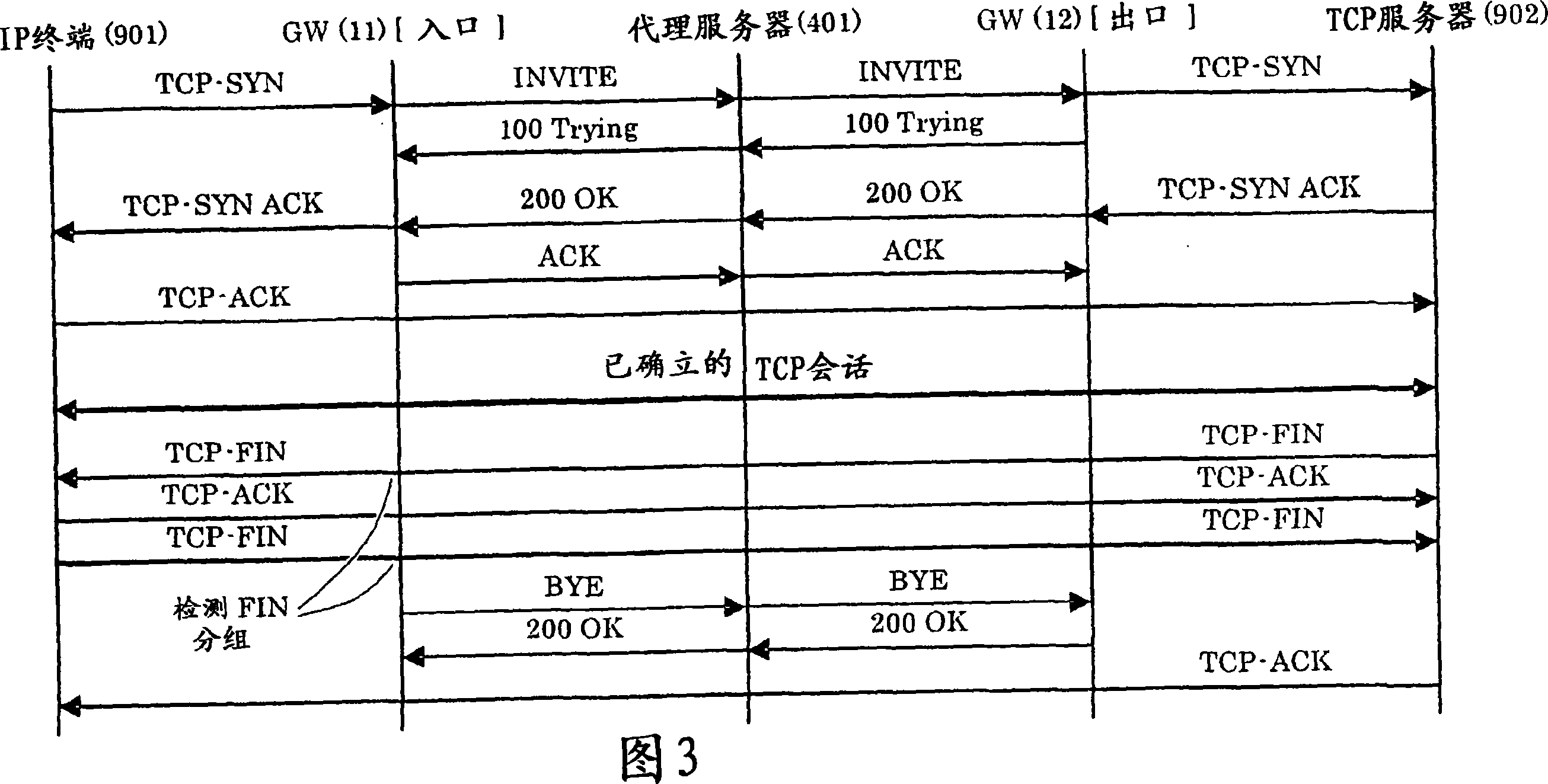IP packet relay method and gateway device in communication network
A communication network and gateway technology, applied in the direction of network connection, data exchange network, data exchange through path configuration, etc., can solve the problem of no call control/call management
- Summary
- Abstract
- Description
- Claims
- Application Information
AI Technical Summary
Problems solved by technology
Method used
Image
Examples
Embodiment 1
[0042] In Embodiment 1, SIP (Session Initiation Protocol), which is highly likely to be widely used as a call control protocol of an IP network in the future, will be described as an example. FIG. 1 shows the basic network structure to which Embodiment 1 is applied. In the network configuration of FIG. 1 , gateway devices (hereinafter referred to as GW devices) 11 and 12 on which the functions of the present invention are installed are realized by IP routers. Of course, this GW device may also be constituted by bridges of layer 2.
[0043] In FIG. 1, subscriber networks 101, 102 are existing IP networks without call control. The core network 201 is a network accompanying call control / call management, and includes core network nodes 301 , 302 , and 303 . The SIP server 401 is connected to the core network 201 and has a SIP proxy server installed as a basic function. 901 and 902 are existing IP terminals or servers located on the user network 101, which can serve as clients a...
Embodiment 2
[0073] Next, Embodiment 2 of the present invention will be described with reference to FIG. 5 . In this second embodiment, the GW devices 11 and 12 transfer all the TCP packets as they are, and the GW device 11 on the ingress side acquires the TCP-SYN-ACK packet from the GW device 12. After synchronization with the SIP 200 OK message, the TCP-SYN-ACK packet is transferred to the IP terminal 901 .
[0074] When the IP terminal 901 issues a TCP-SYN packet as a TCP session establishment request, the GW device 11 acquires the TCP-SYN packet. Then, the GW device 11 transfers the TCP-SYN packet as it is. At the same time, the GW device 12 generates a SIP INVITE packet as a call connection request packet, and transfers the generated SIP INVITE packet (INVITE message) to the SIP proxy server 401 . Upon receiving the INVITE message from the GW device 11, the SIP proxy server 401 transfers the INVITE message to the GW device 12 corresponding to the destination IP terminal. At this ti...
Embodiment 3
[0080] Next, Embodiment 3 of the present invention will be described with reference to FIG. 6 . In this third embodiment, an implementation example of accommodating UDP communication will be described. FIG. 6 shows a sequence of messages related to each constituent element of the network when a UDP session is executed in the configuration shown in FIG. 1 .
[0081] First, the filtering function unit 22 of the GW device 11 detects the first UDP packet transmitted from the IP terminal 901 . Simultaneously with this detection, the filtering function 22 forwards the UDP packet copy to the routing function 23 and the SIP adaptation function 26 of FIG. 2 . The packet transferred to the routing function unit 23 is transferred to the WAN via the WAN port 21 as it is. The packet forwarded to the SIP adaptation function 26 is used to extract the session information used to generate the INVITE message. The generated INVITE message is sent to the GW device 12 via the SIP proxy server 4...
PUM
 Login to View More
Login to View More Abstract
Description
Claims
Application Information
 Login to View More
Login to View More - R&D
- Intellectual Property
- Life Sciences
- Materials
- Tech Scout
- Unparalleled Data Quality
- Higher Quality Content
- 60% Fewer Hallucinations
Browse by: Latest US Patents, China's latest patents, Technical Efficacy Thesaurus, Application Domain, Technology Topic, Popular Technical Reports.
© 2025 PatSnap. All rights reserved.Legal|Privacy policy|Modern Slavery Act Transparency Statement|Sitemap|About US| Contact US: help@patsnap.com



